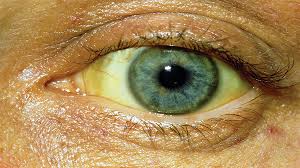What's in this article?
Jaundice, also known as icterus, is a term used to describe a yellowish tinge to the skin and sclerae (the white part of the eye) that is caused by an excess of bilirubin in the blood (hyperbilirubinemia). Body fluids may also be yellow.
The color of the skin and sclerae varies depending on levels of bilirubin; mildly elevated levels display yellow skin and sclerae, while highly elevated levels display brown.
In this article, we will discuss what jaundice is, why it happens, and how it is diagnosed and treated.
Causes of Jaundice
Jaundice most often occurs as a result of an underlying disorder that either causes overproduction of bilirubin or prevents the liver from disposing of it, both of which result in bilirubin being deposited in tissues.
Some underlying conditions that may cause jaundice are:
- Acute inflammation of the liver – may impair the ability of the liver to conjugate and secrete bilirubin, resulting in a buildup.
- Inflammation of the bile duct – may prevent the secretion of bile and removal of bilirubin, causing jaundice.
- Obstruction of the bile duct – prevents the liver from disposing of bilirubin.
- Hemolytic anemia – production of bilirubin increases when large quantities of red blood cells are broken down.
- Gilbert’s syndrome – an inherited condition that impairs the ability of enzymes to process the excretion of bile.
- Cholestasis – a condition where the flow of bile from the liver is interrupted. The bile containing conjugated bilirubin remains in the liver instead of being excreted.
Symptoms of Jaundice
Yellowing of the skin and the whites of the eyes is a sign of infant jaundice that usually appears between the second and fourth day after birth.
To check for infant jaundice, press gently on your baby’s forehead or nose. If the skin looks yellow where you pressed, it’s likely your baby has mild jaundice. If your baby doesn’t have jaundice, the skin color should simply look slightly lighter than its normal color for a moment.
Examine your baby in good lighting conditions, preferably in natural daylight.
Types of Jaundice
The most common types of jaundice are:
Physiological (normal) jaundice
Most newborns have this mild jaundice because their liver is still maturing. It often appears when a baby 2 to 4 days old and disappears by 1 to 2 weeks of age.
Jaundice of prematurity
This is common in premature babies since their bodies are even less ready to excrete bilirubin effectively. To avoid complications, they’ll be treated even when their bilirubin levels are lower than those of full-term babies with normal jaundice.
Breastfeeding jaundice
Jaundice can happen when breastfeeding babies don’t get enough breast milk due to difficulty with breastfeeding or because the mother’s milk isn’t in yet. This is not caused by a problem with the breast milk itself, but by the baby not getting enough of it. If a baby has this type of jaundice, it’s important to involve a lactation (breastfeeding) consultant.
Breast milk jaundice
In 1% to 2% of breastfed babies, jaundice is caused by substances in breast milk that can make the bilirubin level rise. These can prevent the excretion of bilirubin through the intestines. It starts after the first 3 to 5 days and slowly improves over 3 to 12 weeks.
How Jaundice Diagnosed?
Your doctor will give you a bilirubin test, which measures the amount of the substance in your blood. If you have jaundice, your level of bilirubin will be high.
Your doctor will ask you about your symptoms and medical history. She may also give you a physical exam and order tests to check your liver. And she’ll do a complete blood count (CBC) test to find out what caused it.
What Are Jaundice Treatments?
Treatment depends on the cause of the underlying condition leading to jaundice and any potential complications related to it. Once a diagnosis is made, treatment can then be directed to address that particular condition, and it may or may not require hospitalization.
- Treatment may consist of expectant management (watchful waiting) at home with rest.
- Medical treatment with intravenous fluids, medications, antibiotics, or blood transfusions may be required.
- If a drug/toxin is the cause, these must be discontinued.
- In certain cases of newborn jaundice, exposing the baby to special colored lights (phototherapy) or exchange blood transfusions may be required to decrease elevated bilirubin levels.
- Surgical treatment may be required.






Leave a Comment